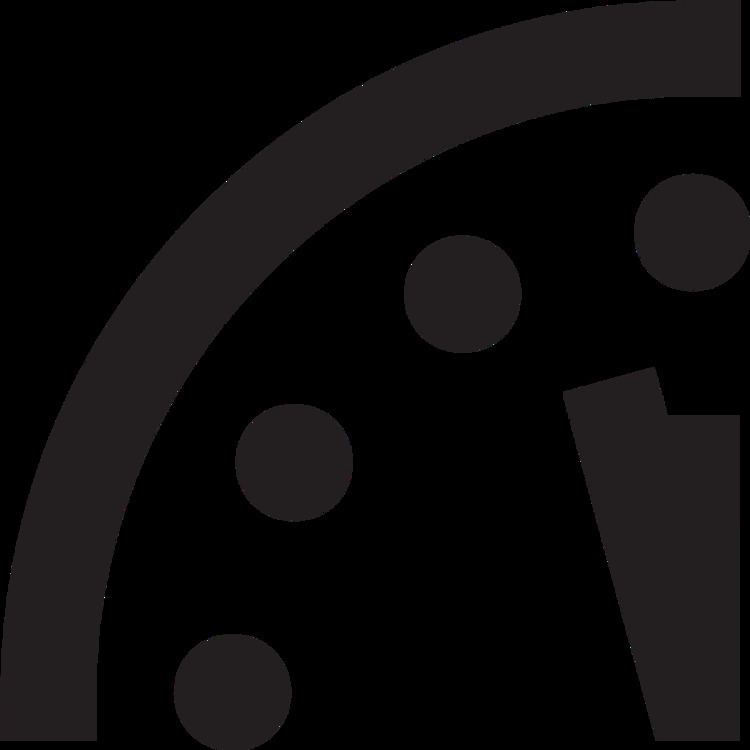 | ||
The Doomsday Clock is a symbol which represents the likelihood of a global catastrophe. Maintained since 1947 by the members of The Bulletin of the Atomic Scientists' Science and Security Board, the Clock, which hangs on a wall in The Bulletin's office in the University of Chicago, represents an analogy for the threat of global nuclear war. Since 2007, it has also reflected climate change and new developments in the life sciences and technology that could inflict irrevocable harm to humanity.
Contents
The Clock represents the hypothetical global catastrophe as "midnight", and The Bulletin's opinion on how close the world is to a global catastrophe as a number of "minutes" to midnight. Its original setting in 1947 was seven minutes to midnight. It has been set backward and forward 22 times since then, the smallest ever number of minutes to midnight being two (in 1953) and the largest seventeen (in 1991). As of January 2017, the Clock is set at two and a half minutes to midnight, due to a "rise of 'strident nationalism' worldwide, United States President Donald Trump's comments over nuclear weapons, and the disbelief in the scientific consensus over climate change by the Trump Administration." This setting is the Clock's second closest approach to midnight since its introduction.
History
The Doomsday Clock's origin can be traced to the international group of researchers called the Chicago Atomic Scientists, who had participated in the Manhattan Project. After the atomic bombings of Hiroshima and Nagasaki, they began publishing a mimeographed newsletter and then the magazine, Bulletin of the Atomic Scientists, which, since its inception, has depicted the Clock on every cover. The Clock was first represented in 1947, when The Bulletin co-founder Hyman Goldsmith asked artist Martyl Langsdorf (wife of Manhattan Project research associate and Szilárd petition signatory Alexander Langsdorf, Jr.) to design a cover for the magazine's June 1947 issue. As Eugene Rabinowitch, another co-founder of The Bulletin, explained later,
The Bulletin's clock is not a gauge to register the ups and downs of the international power struggle; it is intended to reflect basic changes in the level of continuous danger in which mankind lives in the nuclear age...
In January 2007, designer Michael Bierut, who was on The Bulletin's Governing Board, redesigned the Clock to give it a more modern feel. In 2009, The Bulletin ceased its print edition and became one of the first print publications in the U.S. to become entirely digital; the Clock is now found as part of the logo on The Bulletin's website. Information about the Doomsday Clock Symposium, a timeline of the Clock's settings, and multimedia shows about the Clock's history and culture can also be found on The Bulletin's website.
The 5th Doomsday Clock Symposium was held on November 14, 2013, in Washington, D.C.; it was a daylong event that was open to the public and featured panelists discussing various issues on the topic "Communicating Catastrophe". There was also an evening event at the Hirshhorn Museum and Sculpture Garden in conjunction with the Hirshhorn's current exhibit, "Damage Control: Art and Destruction Since 1950". The panel discussions, held at the American Association for the Advancement of Science, were streamed live from The Bulletin's website and can still be viewed there. Reflecting international events dangerous to humankind, the Clock has been adjusted 22 times since its inception in 1947, when it was set to "seven minutes to midnight".
Changes
In 1947, during the Cold War, the Clock was started at seven minutes to midnight ("midnight" being a hypothetical global catastrophe) and was subsequently advanced or rewound per the state of the world and nuclear warfare prospects. The Clock's setting is decided by The Bulletin of the Atomic Scientists's Science and Security Board and is completely arbitrary without a specified starting time. The Clock is not set and reset in real time as events occur; rather than respond to each and every crisis as it happens, the Science and Security Board meets twice annually to discuss global events in a deliberative manner. The closest nuclear war threat, the Cuban Missile Crisis in 1962, reached crisis, climax, and resolution before the Clock could be set to reflect that possible doomsday.
In popular culture
The Clock is featured in the 1986–87 comic book series Watchmen and the 2009 film Watchmen, where it is set at five minutes to midnight. It is also featured in an xkcd comic, where the main character pulls the hour hand forward an hour in accordance with the start of Daylight Saving Time. The title of Iron Maiden's song "2 Minutes to Midnight" is a reference to the Clock.
